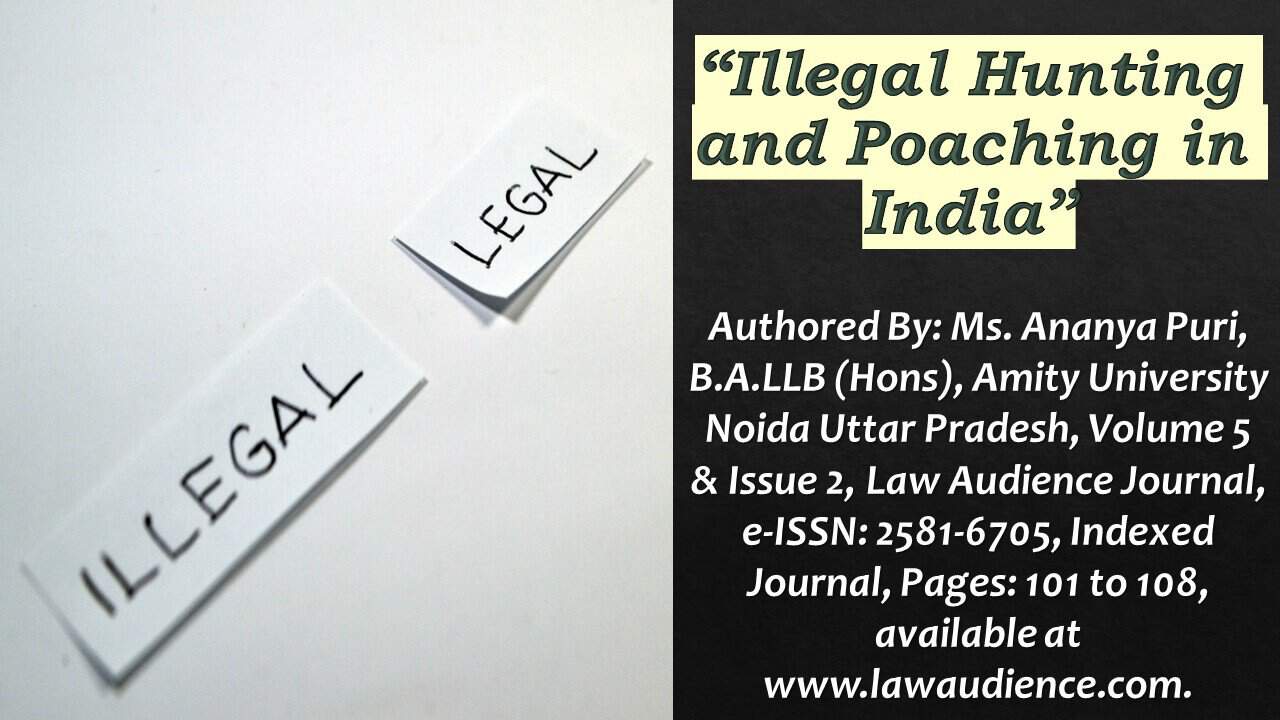Click here to download the full paper (PDF)
Authored By: Ms. Ananya Puri, B.A.LLB (Hons), Amity University Noida Uttar Pradesh,
Click here for Copyright Policy.
ABSTRACT:
“Illegal hunting and poaching are illegal activities that involve the killing, capturing, or trading of wildlife. It is the practice of hunting or killing animals that are protected by law, without proper permits or licenses, or in areas where hunting is prohibited. Poaching can also involve the illegal trade of animal products, such as ivory, rhino horn, or pelts. Illegal hunting and poaching pose a significant threat to wildlife populations and biodiversity. The illegal hunting and poaching of animals can lead to a decrease in their numbers, which can have negative effects on the overall ecosystem. Poaching of endangered species such as elephants, tigers, and rhinos can lead to their extinction, causing irreversible damage to the environment. Illegal hunting and poaching are considered a violation of wildlife protection laws in India. The Wildlife Protection Act, 1972, provides strict regulations for the protection of wildlife, including the prohibition of hunting, poaching, or capturing of protected animals. Violation of these laws can result in severe penalties, including imprisonment and fines. The Wildlife Protection Act of 1972 was implemented to protect the flora and fauna of India from illegal hunting and poaching. This research paper discusses the prevalence of illegal hunting and poaching in India, the impact it has on wildlife, and the effectiveness of the Wildlife Protection Act of 1972 in curbing this problem”.
I. INTRODUCTION:
Illegal hunting and poaching are illegal activities that involve the killing, capturing, or trading of wildlife. It is the practice of hunting or killing animals that are protected by law, without proper permits or licenses, or in areas where hunting is prohibited. Poaching can also involve the illegal trade of animal products, such as ivory, rhino horn, or pelts. Illegal hunting and poaching pose a significant threat to wildlife populations and biodiversity. The illegal hunting and poaching of animals can lead to a decrease in their numbers, which can have negative effects on the overall ecosystem. Poaching of endangered species such as elephants, tigers, and rhinos can lead to their extinction, causing irreversible damage to the environment. Illegal hunting and poaching are considered a violation of wildlife protection laws in India. The Wildlife Protection Act, 1972, provides strict regulations for the protection of wildlife, including the prohibition of hunting, poaching, or capturing of protected animals. Violation of these laws can result in severe penalties, including imprisonment and fines. Illegal hunting and poaching are often driven by the demand for animal products in various markets. In some cases, people engage in illegal hunting and poaching as a means of earning income or as a form of recreation. However, such practices have far-reaching consequences that go beyond the immediate killing of animals. Illegal hunting and poaching can lead to the loss of habitat and the destruction of ecosystems, which can have detrimental effects on other species and the environment as a whole. Illegal hunting and poaching are serious threats to wildlife and biodiversity. The conservation of wildlife and its protection against illegal activities such as hunting and poaching is crucial to maintaining ecological balance and protecting the planet’s natural resources for future generations.
I.I METHODOLOGY:
In order to collect and analyse information in this research paper a technique called secondary data analysis has been utilized, among the sources of secondary data are academic journals on illegal hunting and poaching in India together with related government reports and media articles. In order to uncover suitable secondary data sources for analysis purposes, the research paper employed a systematic approach in reviewing relevant literature and the focus of our study involved conducting a thematic analysis on an array of gathered information which helped us understand distinctive patterns as well as themes associated with unlawful hunting practices such as poaching throughout India. By analyzing secondary data thoroughly in research paper, we can get valuable insights into how illegal hunting and poaching affects both wildlife and the environment in India.
I.II CAUSES OF ILLEGAL HUNTING AND POACHING:
The reasons behind illegal hunting and poaching are complex and multifaceted, driven by a combination of economic, cultural, and environmental factors. Some of the primary reasons behind these activities in India include:
- Demand for wildlife products: One of the primary drivers of illegal hunting and poaching is the demand for wildlife products such as ivory, rhino horns, and tiger bones in international markets. These products are highly valued in traditional Chinese medicine, and there is a significant black market for them in many countries.
- Economic hardship: Many local communities in India hunt wild animals for food or as a source of income, particularly in remote and economically disadvantaged areas. These communities often have few other options for sustenance or income, and hunting may be a traditional and culturally acceptable practice.
- Habitat destruction: The encroachment of human settlements into wildlife habitats has led to habitat destruction and fragmentation, reducing the available space for wildlife populations. This can lead to increased competition for resources, which can exacerbate conflicts between humans and animals.
- Weak law enforcement: Illegal hunting and poaching can be lucrative activities, and some individuals may be motivated to engage in them due to a lack of effective law enforcement. This can be compounded by corruption, with some officials turning a blind eye to illegal activities in exchange for bribes or other incentives.
- Lack of awareness: Many people in India may not be aware of the negative impacts of illegal hunting and poaching on wildlife and ecosystems. This can be due to a lack of education or information, or cultural attitudes that do not prioritise conservation or wildlife protection.
- In conclusion, illegal hunting and poaching are driven by a complex set of economic, cultural, and environmental factors. Addressing these issues will require a multi-faceted approach that includes effective law enforcement, habitat conservation and restoration, and education and awareness-raising efforts.
II. IMPACT OF ILLEGAL HUNTING AND POACHING:
Illegal hunting and poaching in India have led to a significant loss of biodiversity, severely impacting the country’s natural heritage. India is home to a wide variety of wildlife including tigers, elephants, rhinos and leopards. These species play an important role in maintaining ecological balance and are an integral part of the country’s rich and diverse ecosystems.
II.I Loss of Biodiversity:
The loss of these species to illegal hunting and poaching has thrown the ecosystem off balance and has cascading effects that have led to the extinction of other species. It can also lead to deterioration of the health of the ecosystem as a whole. For example, declining tiger populations can lead to increased populations of herbivores such as deer, leading to overgrazing and deforestation. Furthermore, biodiversity loss due to illegal hunting and poaching has long-term consequences for other industries that depend on ecosystem services. Agriculture, fisheries, and forestry all depend on ecosystem services, and the loss of specific species can adversely affect the health of the ecosystem as a whole, leading to lower productivity in these industries.
II.II Threats to endangered species:
Illegal hunting and poaching pose a serious threat to the survival of endangered species in India. India is home to many endangered species such as the giant Indian rhinoceros, snow leopard, Bengal tiger and Indian elephant. These species are protected under the Wildlife Conservation Act 1972, and their survival is important for maintaining ecological balance. Poaching of endangered species is driven by demand for body parts used in traditional medicine, as trophies and ornamentals. For example, Indian rhinoceros horn is highly valued in traditional medicine and is said to have medicinal properties. Similarly, tiger bones and other body parts are used in traditional medicine, and skins are used in the manufacture of luxury goods.
II.III Ecosystem Destruction:
Hunting and poaching deplete the populations of certain species and upset the balance of ecosystems. This can have cascading effects on ecosystems and lead to the extinction of other species. For example, declining tiger populations can lead to increased populations of herbivores such as deer, leading to overgrazing and deforestation. Furthermore, the loss of certain species can have significant impacts on food chains. For example, a decline in predators such as tigers could lead to an increase in herbivore populations and, consequently, a decline in plant species populations. This can have cascading effects on the ecosystem and reduce the health of the ecosystem as a whole.
II.IV Economic Loss:
Wildlife tourism is an important source of income for India. The Ministry of Environment, Forests and Climate Change reports that wildlife tourism in India contributes about 5% of the country’s GDP. However, illegal hunting and poaching can lead to declining wildlife populations, which can adversely affect the tourism industry and lead to lost revenue. Furthermore, biodiversity loss can have long-term consequences for other industries that depend on ecosystem services. For example, agriculture, fishing and forestry all depend on ecosystem services. The loss of specific species can adversely affect the health of entire ecosystems and reduce the productivity of these industries.
II.V Social Impact:
Illegal hunting and poaching, often carried out by organised crime syndicates, can have destabilizing effects on society. These activities can also create conflict between local communities and law enforcement. In addition, illegal hunting and poaching can lead to the displacement of local communities and loss of traditional livelihoods. For example, many communities in India depend on forests for their livelihoods. Poaching and illegal hunting can lead to declining wildlife populations and can have a significant impact on the livelihoods of these communities.
III. EFFECTIVENESS OF WILDLIFE PROTECTION ACT 1972:
The Wildlife Protection Act of 1972 has played a crucial role in curbing illegal hunting and poaching in India. The Act provides legal protection to over 6,000 species of animals and plants, making it one of the most comprehensive pieces of wildlife protection legislation in the world. The Act makes it illegal to hunt, poach, trap, or trade in any protected wildlife species or their products, and sets out strict penalties for violators. It also provides for the establishment of wildlife sanctuaries, national parks, and other protected areas where hunting and other activities are strictly prohibited. One of the key provisions of the Act is the creation of a national network of wildlife wardens and forest officers responsible for enforcing the Act’s provisions. These officers are tasked with investigating cases of illegal hunting and poaching, and prosecuting violators under the Act. The Act has been successful in curbing illegal hunting and poaching in India in several ways. First, it has helped to increase awareness about the importance of wildlife conservation and the need to protect endangered species. This has led to a shift in attitudes towards wildlife, with more people recognising the importance of conserving and protecting these animals. Second, the Act has provided law enforcement agencies with the tools they need to crack down on illegal hunting and poaching. The strict penalties for violators, combined with the establishment of wildlife sanctuaries and other protected areas, have made it increasingly difficult for poachers to operate. Finally, the Act has helped to promote sustainable development and wildlife tourism in India. Many protected areas have become popular tourist destinations, generating revenue for local communities and helping to support conservation efforts. However, despite the successes of the Wildlife Protection Act, illegal hunting and poaching continue to be significant problems in India. The Act’s effectiveness is limited by a range of factors, including weak law enforcement, corruption, and the continued demand for wildlife products in international markets.
IV. ANALYSIS:
the issue of illegal hunting and poaching in India is a serious threat to the survival of many wildlife species, and it has significant ecological, economic, and cultural implications. The Wildlife Protection Act of 1972 is an important tool for combating these illegal activities, but it is not without its shortcomings and challenges. The Act has had many successes, including the establishment of protected areas, the conservation of many endangered species, and the involvement of local communities in conservation efforts. However, there is a need for stronger enforcement, stricter penalties, and increased focus on habitat conservation to effectively combat illegal hunting and poaching in India. The Act should be amended to address its shortcomings, and there should be more efforts to provide adequate resources and improve coordination between different government agencies responsible for wildlife conservation. There is also a need for greater community involvement and awareness to promote a culture of conservation.
V. CONCLUSION:
Illegal hunting and poaching in India are a serious threat to the country’s biodiversity and ecosystems. Unsustainable exploitation of wildlife has led to population declines, with significant impacts on ecosystems and human livelihoods. The loss of biodiversity due to illegal poaching and hunting is throwing ecosystems out of balance, with cascading effects that lead to the extinction of other species. Poaching for ivory and tiger skins has displaced many indigenous communities that depend on these resources for their traditional crafts and livelihoods. In addition, declining populations of some endangered or endangered species such as tigers and rhinos have severely impacted the country’s tourism industry. The Wildlife Protection Act, 1972 is the primary wildlife law in India. The law provides for the establishment of protected areas such as national parks, wildlife reserves and biosphere reserves that are essential for the protection of wildlife and their habitats. The law also imposes severe penalties for illegal hunting and trafficking of wild animals. Penalties include imprisonment from three to seven years and fines for offences related to hunting and wildlife trafficking. The law has helped curb illegal hunting and poaching to some extent, but much more needs to be done to protect India’s wildlife.
Addressing this issue will require effective implementation of wildlife conservation laws, increased public awareness of the need to protect wildlife, sufficient resources and capacity of the Forest Service, and effective enforcement of those involved in illegal poaching and hunting. stricter penalties for It are also important to address the underlying socioeconomic factors that drive illegal poaching and hunting. Additionally, public awareness campaigns are essential to create a society that values and priorities wildlife conservation. Educational initiatives such as school programs and outreach can play an important role in promoting wildlife conservation and reducing demand for illegal wildlife products. Creating alternative livelihoods for local communities, such as ecotourism and sustainable agriculture, can also address the underlying socioeconomic factors driving illegal poaching and hunting. It is also important to tackle corruption and organised crime, which are often involved in illegal wildlife trade. The illegal wildlife trade is worth billions of dollars worldwide, making it an attractive source of income for crime syndicates. Enforcing the law effectively and punishing those involved in the illegal wildlife trade is therefore crucial in combating this problem.
Cite this article as:
Ms. Ananya Puri, “Illegal Hunting and Poaching in India”, Vol.5 & Issue 2, Law Audience Journal (e-ISSN: 2581-6705), Pages 101 to 108 (9th June 2023), available at https://www.lawaudience.com/illegal-hunting-and-poaching-in-india.
References:
- Wildlife Crime Control Bureau. (n.d.). Illegal trade. Retrieved from https://wccb.gov.in/illegal-trade/
- Sharma, A. (2020, November 26). Poaching and hunting laws in India: Overview and significance. India Today. Retrieved from https://www.indiatoday.in/india/story/poaching-and-hunting-laws-in-india-overview-and-significance-1743975-2020-11-26
- Acharjya, D. P., & Begum, S. (2019). Impact of wildlife poaching on biodiversity: A review. Journal of Ecology and Environmental Sciences, 3(2), 181-190.
- Bhattacharjee, S., & Kumara, H. N. (2016). Wildlife conservation in India: Evolution and current scenario. Journal of Ecology and Environmental Sciences, 4(2), 64-75.
- Nair, S. S., & Patil, S. S. (2020). A review of the illegal trade of wildlife in India. Biodiversity International Journal, 4(2), 45-52.
- Sharma, R. K. (2019). Illegal hunting and poaching: A threat to wildlife in India. International Journal of Conservation Science, 10(4), 861-868.
- WWF-India. (2018). Illegal wildlife trade in India: An analysis. Retrieved from https://www.wwfindia.org/illegal_wildlife_trade_in_india_an_analysis.php.



